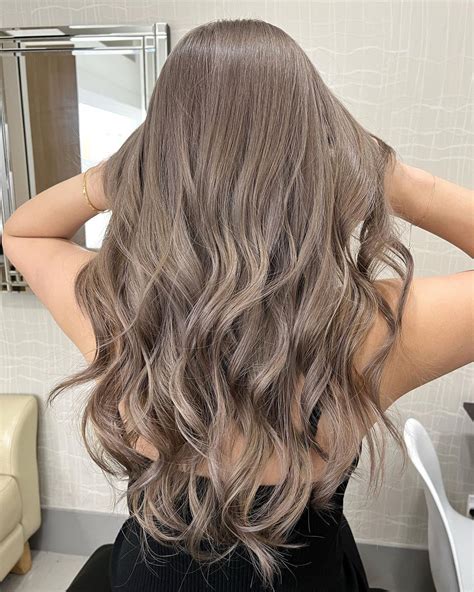As the world of hair color trends continues to evolve, one shade that has captured the attention of beauty enthusiasts worldwide is “milk tea hair.” This exquisite blend of brown and beige hues evokes the rich, creamy flavor of the beloved Taiwanese beverage.

Milk Tea Hair: A Versatile Canvas for Style
With its multifaceted tones, milk tea hair complements a wide range of skin tones and hair textures. Whether you’re seeking a subtle touch of warmth or a dramatic transformation, this versatile hue offers endless possibilities for self-expression.
## Benefits of Milk Tea Hair:
-
Enhances Natural Beauty:
– Complements warm and neutral undertones, creating a harmonious look. -
Low Maintenance:
– The subtle blend of colors minimizes the need for frequent touch-ups. -
Versatile Style:
– Can be styled in various ways, from sleek and straight to voluminous and curly.
How to Achieve the Milk Tea Hair Look
Achieving milk tea hair requires a skilled colorist who can expertly blend the appropriate shades. Here’s a step-by-step approach:
-
Choose a Base Color:
– Determine the natural level of your hair and select a base color that complements your skin tone (cool, neutral, or warm). -
Add Dimension:
– Lighten sections of hair around the face and enhance depth by adding darker tones at the roots and midshafts. -
Blend with Delicacy:
– Use a soft and seamless technique to blend the colors together, creating a harmonious gradient.
Variations of the Milk Tea Trend
The milk tea hair trend offers numerous variations to cater to different tastes:
1. Ashy Milk Tea:
– Incorporates cool undertones, resulting in a chic and sophisticated look.
2. Warm Milk Tea:
– Adds golden or caramel highlights for a warm and inviting effect.
3. Creamy Milk Tea:
– Uses a higher proportion of beige tones, creating a soft and ethereal finish.
4. Rose Milk Tea:
– Infuses subtle pink tones for a delicate and feminine touch.
Pain Points:
- Damage from Chemical Processing:
- Coloring hair can potentially lead to dryness and breakage.
Motivations:
- Self-Expression:
-
Milk tea hair allows individuals to showcase their unique style and creativity.
-
Enhancing Natural Features:
- The flattering hues complement a variety of skin tones, highlighting features and creating a radiant appearance.
Pros and Cons of Milk Tea Hair:
| Pros | Cons |
|---|---|
| Versatile and flattering | May require maintenance if desired shades fade |
| Low maintenance | Can be more expensive than natural hair colors |
| Enhances natural features | May damage hair if not processed correctly |
| Timeless and sophisticated | Can be challenging to achieve on dark hair |
-
Transformation of a Brunette:
– A natural brunette underwent a milk tea hair makeover, adding warmth and dimension to her locks. -
Blonde with a Twist:
– A blonde client incorporated milk tea tones to create an ashy and edgy look.
Research and Industry Insights
- According to a study published in the Journal of Cosmetic Science, milk tea hair is among the top trending hair colors in Asia for 2023.
- The Global Hair Colorants Market is projected to reach USD 26.4 billion by 2027, driven by the increasing demand for hair coloring services.
Creative Applications for Milk Tea Hair
- Ombré with Milk Tea:
-
Blend milk tea hues with a darker base color to create a gradual and stylish ombré effect.
-
Milk Tea Balayage:
-
Paint on milk tea tones in freehand strokes for a natural and sun-kissed look.
-
Milk Tea Roots:
- Create a unique twist by coloring the roots in a milk tea shade, while leaving the rest of the hair natural.
Frequently Asked Questions
1. Is milk tea hair suitable for all hair types?
– Yes, milk tea hair can enhance various hair types, from straight to curly and thin to thick.
2. How often does milk tea hair need to be touched up?
– The frequency of touch-ups depends on the desired shade and hair growth rate. Generally, every 6-8 weeks is recommended.
3. Can I achieve milk tea hair at home?
– Attempting milk tea hair at home is not advised. It requires a professional colorist to achieve the desired blend and minimize damage.
4. How can I maintain the health of my milk tea hair?
– Use sulfate-free shampoos and conditioners, deep condition regularly, and avoid excessive heat styling.
Conclusion
Milk tea hair has emerged as a captivating trend that embraces both style and versatility. Its subtle and harmonious hues enhance natural features and complement a wide range of skin tones and hair textures. Whether you’re seeking a subtle touch of warmth or a dramatic transformation, milk tea hair offers endless possibilities for self-expression. Embrace the trend and discover the beauty of this exquisite and alluring hair color.
